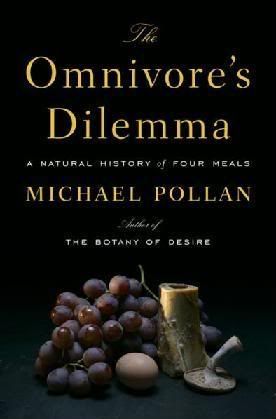|
Saturday, June 28, 2008
I Have Met the Enemy, and It Is Corn
Title: The Omnivore’s Dilemma
Author: Michael Pollan

What is perhaps most troubling, and sad, about industrial eating is how thoroughly it obscures all these relationships and connections. To go from the chicken (Gallus gallus) to the Chicken McNugget is to leave this world in a journey of forgetting that could hardly be more costly, not only in terms of the animal’s pain but in our pleasure, too. But forgetting, or not knowing in the first place, is what the industrial food chain is all about, the principal reason it is so opaque, for if we could see what lies on the far side of the increasingly high walls of our industrial agriculture, we would surely change the way we eat.
I’ll come straight and admit it – I have a deep fondness for Chicken McNuggets. They’re crispy (sort of), easily-chewable, and perfectly designed so that I can eat them with one hand while driving. Michael Pollan’s The Omnivore’s Dilemma won’t stop me from scarfing McNuggets during my next visit to a Pennsylvania Turnpike rest stop. But I will feel guilty about it.
The Omnivore’s Dilemma, as Pollan himself says, is a very long answer to a very short question: What should we have for dinner? For humans, this is a serious question deserving serious thought. A koala doesn’t think about what to have for dinner. It’s all eucalyptus, all the time. Breakfast, lunch, dinner, dessert. Eucalyptus. But we humans can eat many things – flora, fauna, fungi. We’re omnivores (just like rats). Therefore, we have to exert considerable brain power deciding what to eat, so we don’t chow down something that poisons us.
In The Omnivore’s Dilemma, Pollan traces the origins of three different food chains: the industrial, the organic, and the hunter-gatherer. It’s a fascinating journey, full of surprise twists and turns. For instance, I learned that almost every strand in the industrial food chain leads back to corn. Corn sweetens our foods (high fructose corn syrup), feeds our meat (animals raised in factory farms are fed corn), and provides many of the incomprehensible ingredients on processed food labels (lecithin, triglycerides, and even citric acid). To eat a Chicken McNugget and Coke, Pollan points out, is to have corn with your corn. And because corn produces a unique carbon isotope, scientists can determine how much corn-generated carbon is in an individual’s diet by measuring the amount of that isotope in their hair. One biologist performing this experiment said, “We North Americans look like corn chips with legs.”
Also included is the incredible story of Fritz Haber, who developed the process for fixing nitrogen, a key ingredient in synthetic fertilizer. Before Haber’s invention, the Earth’s population was strictly limited by the nitrogen that could be fixed by legumes and fungi. Some call Haber’s invention the most important scientific development of the 20th century, and estimate that 2 out of 5 people alive today would not exist but for Haber. And yet, no one celebrates him. The reason? Haber threw himself into the WWI German war effort, developing synthetic nitrate for bombs and, later, poisonous gases. One day, distraught that her husband had turned into Dr. Death, Mrs. Haber, also a chemist, killed herself with her husband’s army pistol.
So much for the industrial food chain. The organic and hunter-gatherer trails are just as interesting. Just how organic is that apple from Whole Foods? How much food can an acre of sustainably-farmed land produce? And just how far will a passionate mushroom hunter go to protect a good porcini spot?
This book presents many good reasons why we should change our eating habits. But I found one particularly convincing, and it has nothing to do with the environment or animal cruelty. It has to do with taste. Pollan mentions several interviews with people who have made the conscious decision to eat organic. Among the older individuals, a common theme was, “I just want to eat food that tastes like I how remember it. Chicken doesn’t taste like chicken anymore.”
Have Americans forgotten tastes? Do we eat so much bland, processed food that we don’t notice how flavorless everything is? Perhaps. All I can say is that this summer I have visited three different grocery stores in search of watermelon, only to find that the only variety available was personal-size “seedless” watermelons. I’ve eaten two of these monstrosities now, and both were nothing like the red juiciness I crave. Where are all the normal watermelons? Makes me wonder.
Highly recommended.Labels: corn, food, industrial farming, non-fiction, organic food
posted by Elizabeth at
12:00 PM

0 Comments:
|
|

